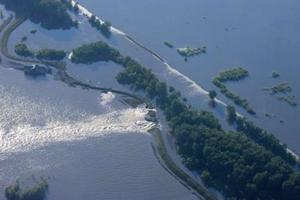Infrastructure protectionLocal officials oppose “unacceptable” levee ratings
In recent years as part of an effort to bolster the nation’s flood protection infrastructure, the Army Corps of Engineers has analyzed and declared more than 200 levee systems across the country as “unacceptable,” resulting in a firestorm of criticism from local officials

Missouri River levee break in 2008 // Source: altervista.org
In recent years as part of an effort to bolster the nation’s flood protection infrastructure, the Army Corps of Engineers has analyzed and declared more than 200 levee systems across the country as “unacceptable,” resulting in a firestorm of criticism from local officials.
Critics of the new ratings say that the Corps is overreacting in its attempt to prevent another Hurricane Katrina and imposing unrealistic safety standards that local communities cannot afford.
The latest back and forth stems from the creation of a new database of the nation’s 2,200 federal levee systems. 10 percent of the nation’s levees have been declared “unacceptable,” including those in East St. Louis, Dallas, Sacramento, and St. Paul. Only 9 percent of the nation’s levees have been rated “acceptable, while 80 percent have been deemed “minimally acceptable.”
The unacceptable rating does not mean these levees are unsafe, but instead suggest that they are subject to heightened risk of failure in cases of extreme flooding.
In East St. Louis, Illinois, where its sixty-five miles of levees have been declared unacceptable, local officials are firing back.
“Basically, the corps has said, ‘We are not going to make those mistakes again,’ ” said Les Sterman, the chief supervisor for the Southwestern Illinois Flood Protection District Council, in reference to Hurricane Katrina. “It seems to me the risk that they’re mostly protecting from is the risk to the bureaucracy, as opposed to the risk to the public.”
In defense of the rating, Colonel Christopher G. Hall, the commander of the St. Louis District for the Corps, said standards have not changed, but improved technologies have allowed engineers to more accurately assess the condition of the soil beneath the levees.
People “don’t like to hear that they have a level of risk,” Colonel Hall said, but “everybody lives with some risk.”
Eric Halpin, the special assistant for dam and levee safety at Corps headquarters in Washington, explained that the agency is enforcing its safety regulations more consistently now. “We’re going to hold public safety paramount,” he said. “The people that work and live behind the levees are the most important thing.”
The levees ringing St. Louis protect 112,000 acres and keep nearly 300,000 residents safe from floods in addition to preventing potential flood damage estimated at $12 billion.
Local officials acknowledge that safety is paramount but fear that that the Corp’s actions could hinder economic growth by causing the Federal Emergency Management Agency to alter its flood maps that would force
